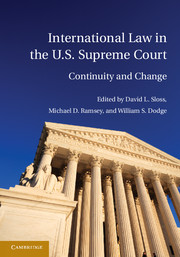Book contents
- Frontmatter
- Contents
- List of Contributors
- Table of Cases
- Acknowledgments
- Introduction
- PART I FROM THE FOUNDING TO THE CIVIL WAR
- PART II FROM THE CIVIL WAR TO THE TURN OF THE CENTURY
- PART III FROM THE TURN OF THE CENTURY TO WORLD WAR II
- PART IV FROM WORLD WAR II TO THE NEW MILLENNIUM
- PART V INTERNATIONAL LAW IN THE U.S. SUPREME COURT IN THE TWENTY-FIRST CENTURY
- V.A TREATIES AFTER 2000
- V.B CUSTOMARY INTERNATIONAL LAW AFTER 2000
- V.C INTERNATIONAL LAW AND CONSTITUTIONAL INTERPRETATION AFTER 2000
- Main Essay – International Law and Constitutional Interpretation in the Twenty-First Century: Change and Continuity
- Response – Essay Why Constitutional Comparativism Is Different: A Response to Professor Tushnet
- Response Essay – Judicial Dialogue in Roper: Signaling the Courts Emergence as a Transnational Legal Actor?
- V.D INTERNATIONAL LAW AND STATUTORY INTERPRETATION AFTER 2000
- V.E INTERNATIONAL LAW AND THE WAR ON TERROR
- VI CONCLUSION
- Index
- References
Response Essay – Judicial Dialogue in Roper: Signaling the Courts Emergence as a Transnational Legal Actor?
Published online by Cambridge University Press: 05 July 2011
- Frontmatter
- Contents
- List of Contributors
- Table of Cases
- Acknowledgments
- Introduction
- PART I FROM THE FOUNDING TO THE CIVIL WAR
- PART II FROM THE CIVIL WAR TO THE TURN OF THE CENTURY
- PART III FROM THE TURN OF THE CENTURY TO WORLD WAR II
- PART IV FROM WORLD WAR II TO THE NEW MILLENNIUM
- PART V INTERNATIONAL LAW IN THE U.S. SUPREME COURT IN THE TWENTY-FIRST CENTURY
- V.A TREATIES AFTER 2000
- V.B CUSTOMARY INTERNATIONAL LAW AFTER 2000
- V.C INTERNATIONAL LAW AND CONSTITUTIONAL INTERPRETATION AFTER 2000
- Main Essay – International Law and Constitutional Interpretation in the Twenty-First Century: Change and Continuity
- Response – Essay Why Constitutional Comparativism Is Different: A Response to Professor Tushnet
- Response Essay – Judicial Dialogue in Roper: Signaling the Courts Emergence as a Transnational Legal Actor?
- V.D INTERNATIONAL LAW AND STATUTORY INTERPRETATION AFTER 2000
- V.E INTERNATIONAL LAW AND THE WAR ON TERROR
- VI CONCLUSION
- Index
- References
Summary
In a characteristically thoughtful and original essay, Professor Mark Tushnet contends that Roper v. Simmons is consistent with a long line of U.S. Supreme Court precedent utilizing international sources in constitutional interpretation. Given this consistency with prior practice, Professor Tushnet asserts that the controversy over Roper “must rest on something new in constitutional discourse.” He finds the “something new” in two sources: the rise of originalism and renewed “concern for the place of the United States in the modern international order.”
In this brief response, I suggest two more sources for the controversy over Roper. The first is an additional “something new in constitutional discourse”: the emerging transnational judicial dialogue among the world's constitutional courts on human rights issues and the concomitant emergence of constitutional courts as important mediators between domestic and international law. Building on Professor Tushnet's insights with respect to Roper's impact on debates over national identity, I ground criticism of the Court's decision in part on the fear that American judges might become active participants in the dialogue on human rights and that this might have negative consequences for the United States' so-called national identity.
Second, I argue that controversy over Roper is grounded in part on “something new” with respect to the Court's use of non-U.S. sources. Seen against the backdrop of the emerging transnational judicial dialogue on human rights, Justice Anthony Kennedy's reliance on nonbinding human rights treaties represented a significant departure from – or at least expansion of – the Court's prior practice.
- Type
- Chapter
- Information
- International Law in the U.S. Supreme Court , pp. 523 - 530Publisher: Cambridge University PressPrint publication year: 2011

